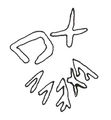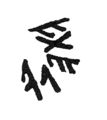VA·2
| Inscription | |
|---|---|
| Reading in transliteration: | atep̣ạ / to |
| Reading in original script: | |
| Variant reading: | atep̣ạ / ot |
|
| |
| Object: | VA·2 Cantello (pot) |
| Position: | foot, outside |
| Direction of writing: | sinistroverse |
| Script: | North Italic script (Lepontic alphabet) |
| Number of letters: | 7 |
| Number of words: | 2 |
| Number of lines: | 2 |
| Workmanship: | scratched after firing |
| Condition: | complete, damaged |
|
| |
| Archaeological culture: | unknown [from object] |
| Date of inscription: | unknown [from object] |
|
| |
| Type: | unknown |
| Language: | Celtic |
| Meaning: | 'Atepa ?' |
|
| |
| Alternative sigla: | Tibiletti Bruno 1981: 22 Solinas 1995: 118 bis Motta 2000: 17 b Morandi 2004: 42 |
|
| |
| Sources: | Morandi 2004: 545 no. 42 |
Images
Commentary
First published in Tibiletti Bruno 1977b: 124–126, no. 104 g. Currently untraceable.
Images in Tibiletti Bruno 1977b: 125 (photo), Solinas 1995: 371, no. 118 bis (drawing), Morandi 2004: 548, fig. 11.42 (drawing) (both drawings presumably made from the photograph).
Inscribed on the foot of the vessel, atepa along the rim (bottom), to in larger letters above it. The surface is damaged especially in the lower areas of pi and the second alpha. No reading based on an examination is available; Tibiletti Bruno on the basis of the original photograph is certain about all letters but the second alpha ("forse si intravvede a, scritto però con una incisione più leggera (o la coincidenza di certe linee è del tutto casuale?)" p. 124), whose upper bar seems to be visible.
The inscription as a whole could theoretically be read atepato, an o-stem name with lost final -s or an on-stem with Latinised -ō for -ū, which finds a comparandum in the cognomen atepatus (CIL XII 2905, Cruviers). As observed by Tibiletti Bruno, however, it is not evident why the writer should not have continued along the rim. Omicron and St. Andrew's cross are not only larger than the other letters, but also misaligned; the ductus is more square than that of the letters in the longer sequence. Furthermore, atepato would require one to read line 2 before line 1; actual boustrophedon (real or false/inverted) would yield implausible atepaot. Unless the writer was seized by a sudden spell of horror vacui, the two-letter sequence is separate from atepa.
atepa can be analysed as a Celtic personal name, finding comparanda in Cisalpine as well as Transalpine Gaulish (see the word page and cf. esp. atepo (dat.) on a 1st c. Roman stela from Casalzuigno, Varese, Sartori 2009: 218, VA18.02). Whether to (or ot) is an abbreviation of another name (see the word pages) or a non-script mark cannot be determined.
Morandi 2004 dates the inscription to the 3rd century BC "per gli aspetti epigrafici".

